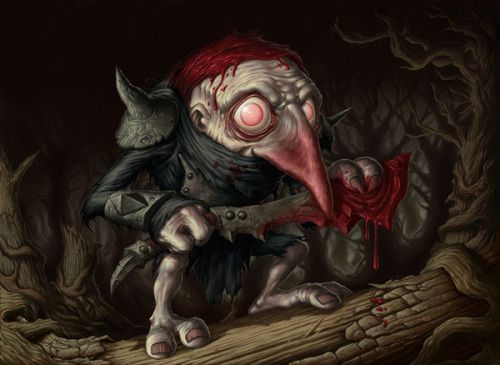In European mythology, gnomes are humanoid creatures that live on the earth, underground, and in the mountains. Often they were associated with unearthly wisdom, blacksmithing, mining and jewelry. Sometimes gnomes are portrayed and described as low, grotesque and ugly monsters, but some culturologists believe that such an atypical view of them is associated with a later (renaissance) fashion in sinister forms.
Dwarves are still part of modern folk culture in many countries, and it was through it that they got into the mass culture, becoming familiar characters in computer games, books, feature films and animated films. In popular culture, they are as ubiquitous and popular as elves, werewolves, and vampires, so the question of whether gnomes exist continues to be relevant.
Gnomes in Norse mythology
The most ancient sources mentioning the gnomes belong to the artifacts of Scandinavian paganism, whose cosmology boasts two separate myths about the origin of these fabulous creatures. One of these myths claims that the gnomes were born from the blood and bones of the giant Ymir, whose flesh was used to create the Earth, while another myth claims that they were originally beast-like creatures who sought to swallow the giant’s corpse. The latest version of the origin - you must admit, rather gloomy - corresponds to many Old Norse ideas about these creatures as evil and treacherous demons. Very often, however, gnomes are depicted in Scandinavian mythology as exceptional blacksmiths, but their overwhelming characteristic remains negative.

The Scandinavians considered the Dwarves to be greedy, lustful and vindictive dwarfs, ready to go to kill a man for the sake of Poetry Honey, which, according to some legends, can be boiled from human blood. This terrible look at the gnomes further connected them with the almost universally offended race - the trolls, in connection with which beliefs began to appear in which the gnomes, like trolls, turn into stone at the sight of daylight.
Some Old Norwegian sources link them to the dark elves, known as Svartalfar. The belief in these creatures was so strong among the ancient Norwegians that they never wondered if the gnomes exist.
Dwarves in Anglo-Saxon mythology
In the Anglo-Saxon tradition, gnomes were often described as entities that could cause people to have trouble sleeping, such as nightmares, bouts of night horror, and sleep paralysis. Mythologist Lotte Motz argues that ideas about these creatures did not arise in the pre-Christian era, but much earlier - in the Neolithic era, which determined the face of European continental culture.
Many people are very interested in the question whether a money gnome exists. The Anglo-Saxons did not ask this question: in their view, some dwarves could both steal money and leave them in secluded places. The idea of them, living in apartments and leaving a trifle under the bed, still exists in the UK and the USA. From there it migrated to us.
Dwarves in the mythology of other countries
In the Russian language there is no special name for the zerg and Nain - creatures from German and French mythology, which, in essence, are only a local analogue of gnomes.
The French folklorist Gerard Leser once published a detailed work on the distinction of Nain, Dwarfs, Dwarves and Lutens, illustrating them with examples from the mythology of Alsace, a region located at the junction of French and German cultures. According to Alsatian beliefs, gnomes and Naines differ from each other primarily in their growth (gnomes are much lower than Naines), but brings their common place of residence - dungeons and mines. Lutens live on the earth, huddling near human dwellings, which makes them look like our brownies.
Leser did not write about whether all of the above creatures exist, leaving the reader with the right to his own conclusion.
Dwarves in real life
We cannot know for sure whether the gnomes actually exist. But we definitely know about the existence of dwarfs - people with abnormally small stature. In the Middle Ages, this fact was often explained by the fact that a child suffering from this disease was an ordinary foundling abandoned by the dwarves, while a real child was abducted by these underground creatures for some mysterious purposes. Even the English word dwarf has two meanings, designating both a fairy gnome and a person born with a dwarf disease.
But today it is reliably known that dwarfism is a genetic disease, and people suffering from it have nothing to do with fabulous creatures from medieval legends. And so the question of whether gnomes exist still remains open.
Rumpelstiltskin
Is there a gnome that fulfills desires? Medieval Germans believed in a dwarf named Rumpelstiltskin, who was able to fulfill wishes for a fee (often a very large one). Desperate people turned to each dwarf they met to return their loved ones, heal from illness or enrich, sometimes giving all their belongings for this opportunity. The result, however, very rarely satisfied them, and the miserable midgets, who decided to enrich themselves with human stupidity, got it to the fullest.
Pictures of gnomes
The main argument of people who believe that gnomes exist is photos taken in Argentina.
In addition to the photo there is also a video, which captures a crouching small creature that resembles a gnome from fairy tales in silhouette. This video was never exposed by any skeptics, and therefore it can be considered an indirect answer to the burning question of whether gnomes exist.